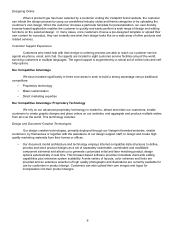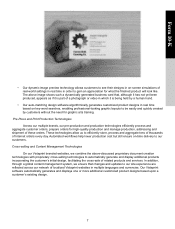Vistaprint 2014 Annual Report Download - page 20
Download and view the complete annual report
Please find page 20 of the 2014 Vistaprint annual report below. You can navigate through the pages in the report by either clicking on the pages listed below, or by using the keyword search tool below to find specific information within the annual report.16
In addition, integrating newly acquired businesses, technologies, and services and monitoring and
managing our investments and joint ventures are complex, expensive, time consuming and subject to many risks,
including the following:
• We may not be able to retain customers and key employees of the acquired businesses, and we and
the businesses we acquire or invest in may not be able to cross sell products and services to each
other's customers.
• In some cases, our acquisitions and investments are dilutive for a period of time, leading to reduced
earnings. For example, the Albumprinter and Webs acquisitions have resulted in additional intangible
asset amortization and share-based compensation expense.
• An acquisition or investment may fail to achieve our goals and expectations because we fail to integrate
the acquired business, technologies, or services effectively, the integration is more expensive or takes
more time than we anticipated, the management of our investment is more expensive or takes more
resources than we expected, or the business we acquired or invested in does not perform as well as
we expected.
• Acquisitions and investments can result in large write-offs including impairments of goodwill and
intangible assets if financial goals are not achieved, assumptions of contingent or unanticipated
liabilities, or increased tax costs.
We often pay a portion of the purchase price for our acquisitions in the form of an earn-out. For example, in
addition to the initial purchase consideration we paid for People & Print Group, we agreed to a sliding scale earn-
out that is based on People & Print Group's revenue and EBITDA targets for calendar year 2015. We accrue
liabilities for estimated future contingent earn-out payments based on an evaluation of the likelihood of achievement
of the contractual conditions underlying the earn-out and weighted probability assumptions of the required
outcomes.
As a component of the purchase price of People & Print Group, we included an estimated acquisition date
fair value and recorded a liability of $9.8 million (€7.2 million) for the earn-out payment as of June 30, 2014. The
earn-out amount is theoretically unlimited and could be significant in relation to the base purchase price.
In addition to our contingent earn-out liability relating to People & Print Group, we had contingent earn-out
liability related to the Pixartprinting acquisition of $6.3 million (€4.6million) as of June 30, 2014. The earn-out
amount is limited to a maximum payment of $13.2 million (€9.6 million).
If in the future our assumptions change and we determine that higher levels of achievement are likely under
our earn-outs, we will need to pay and record additional amounts to reflect the increased purchase price. Such
additional amounts could be significant and adversely impact our liquidity, financial condition and results of
operations.
Seasonal fluctuations in our business place a strain on our operations and resources.
Our business is highly seasonal. Our second fiscal quarter includes the majority of the holiday shopping
season and accounts for a disproportionately high portion of our earnings for the year, primarily due to higher sales
of home and family products such as holiday cards, calendars, photo books, and personalized gifts. Revenue
during the second fiscal quarter represented 30%, 30%, and 29% of annual revenue in the years ended June 30,
2014, 2013, and 2012, respectively, and operating income during the second fiscal quarter represented 61%, 72%,
and 59% of annual operating income in the years ended June 30, 2014, 2013, and 2012, respectively. In
anticipation of increased sales activity during our second fiscal quarter holiday season, we typically incur significant
additional capacity related expenses each year to meet our seasonal needs, including facility expansions,
equipment purchases, and increases in the number of temporary and permanent employees. Lower than expected
sales during the second quarter would likely have a disproportionately large impact on our operating results and
financial condition for the full fiscal year. In addition, if our manufacturing and other operations are unable to keep
up with the high volume of orders during our second fiscal quarter, we and our customers can experience delays in
order fulfillment and delivery and other disruptions. If we are unable to accurately forecast and respond to
seasonality in our business, our business and results of operations may be materially harmed.
























